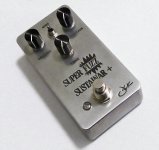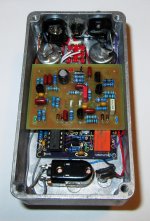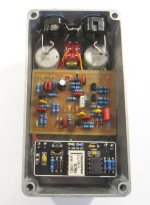PedalBuilder
Well-known member
As @Aleph Null (and many others among us) can attest, spelling errors can have shockingly long lives. But when it comes to pedals, few have had a longer life when some anonymous employee of Hoshino Gakki decided to name the company's new Big Muff clone "Super Fuzz Sustainar." It's about 53 years later and the spelling error is still with us:

Obligatory gut shot:

I used one of my Big Muff boards for this build, but you can definitely build this on a Muffin Fuzz PCB if you use the values on the schematic at the bottom of this post. The PCB was designed to use parallel silver mica capacitors for the Q1-3 base-collector filter capacitors, but I built this one with C0G ceramics, so the extra capacitor footprints were left unpopulated. The enclosure is a white Tayda 125B with a matte varnish over the UV print. My usual I/O board and relay bypass board as always.
As is the case with just about every Big Muff, Kit Rae has a nice write-up on it:
The original Sustainar was built with some of the cheapest components available—a flimsy folded metal enclosure, cheap jacks, carbon comp resistors that increase in resistance over time. But worst of all were the capacitors, ceramic disks with "Z" tolerance, i.e. +80% / -20%, meaning the 100nF capacitors between each gain stage could be anywhere from 80nF to 180nF.
When I started out breadboarding the circuit, I followed the values listed on Kit Rae's schematic. When I tried it out, I was not very pleased with the sound. It was a weird blend of muddy and buzzy and didn't sound very much like any of the demos that I had heard. And so I started "drifting" the components to see if that made an improvement. And sure enough, it did! Thundering low end, but not muddy, and plenty of high end buzz and sizzle. With the tone control all the way to the left, there's a sudden and massive volume boost. While that position is typically very dark on other Big Muff variants, the tiny 330pF capacitor in the tone stack ensures that there's still enough high end to get you a cool and very useable tone. (The original used audio taper pots and had the tone control wired backwards compared to most other Big Muffs; I used a C-taper wired normally to get the same sweep.) Here's a schematic showing the changes that I made to the values in case anyone else wants to give it a try:

The lower gain transistors make a huge difference. I started off with BC549B and 2N3904 with gains in the 220-250 range; switching to the BC337-16 and PN2222A gave it a brighter and raunchier tone.
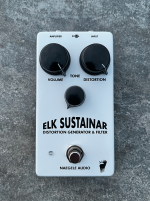
Obligatory gut shot:

I used one of my Big Muff boards for this build, but you can definitely build this on a Muffin Fuzz PCB if you use the values on the schematic at the bottom of this post. The PCB was designed to use parallel silver mica capacitors for the Q1-3 base-collector filter capacitors, but I built this one with C0G ceramics, so the extra capacitor footprints were left unpopulated. The enclosure is a white Tayda 125B with a matte varnish over the UV print. My usual I/O board and relay bypass board as always.
As is the case with just about every Big Muff, Kit Rae has a nice write-up on it:
Among the many Japanese Big Muff clones, one of the first on the market was the Super Fuzz Sustainar, a nearly exact clone of a 1972 era Big Muff made by the Hoshino Gakki company (early units possibly made by Miyuki Ind. Co.) sometime around 1973. . . . These were sold throughout the 1970s, and not long after its introduction, Gakki shamelessly changed the name from Super Fuzz to Big Muff. The pedals marked Electro Sound are the earliest, and those marked Elk Incorporated or Elk/Gakki are the later made production.
The circuit is identical to a PNP triangle circuit from 1972. . . . The only change made was the high pass cap in the tone section at C9. Typically .004µF, it was changed to 330pF in the Sustainar. This had the effect of retaining treble when the tone pot was turned to the bass side, making the bass range more useful. When fully in the bass position the overall volume level is significantly higher than other tone settings as well.
The original Sustainar was built with some of the cheapest components available—a flimsy folded metal enclosure, cheap jacks, carbon comp resistors that increase in resistance over time. But worst of all were the capacitors, ceramic disks with "Z" tolerance, i.e. +80% / -20%, meaning the 100nF capacitors between each gain stage could be anywhere from 80nF to 180nF.
When I started out breadboarding the circuit, I followed the values listed on Kit Rae's schematic. When I tried it out, I was not very pleased with the sound. It was a weird blend of muddy and buzzy and didn't sound very much like any of the demos that I had heard. And so I started "drifting" the components to see if that made an improvement. And sure enough, it did! Thundering low end, but not muddy, and plenty of high end buzz and sizzle. With the tone control all the way to the left, there's a sudden and massive volume boost. While that position is typically very dark on other Big Muff variants, the tiny 330pF capacitor in the tone stack ensures that there's still enough high end to get you a cool and very useable tone. (The original used audio taper pots and had the tone control wired backwards compared to most other Big Muffs; I used a C-taper wired normally to get the same sweep.) Here's a schematic showing the changes that I made to the values in case anyone else wants to give it a try:
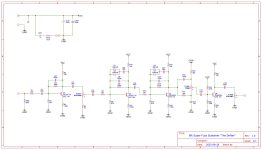
The lower gain transistors make a huge difference. I started off with BC549B and 2N3904 with gains in the 220-250 range; switching to the BC337-16 and PN2222A gave it a brighter and raunchier tone.

